________________
Shruti Rai & Surjya Kamal Borah
SAMBODHI
At the time of speaking, the very first man (mental organ) and then vāc (sense organ of speaking) becomes active. Now, organs of articulation come in movement, and through the svara yantra, pudgala/parmāņu of sounds are transformed into the speech sounds. At the most outer level, speaker exhales these speech sounds into the form of sequential language. Coming out, these pudgala starts moving (praāsrna) throughout the ākāśa. These speech sounds (dhvani taranga) spread by the lokanta1 as the language is pervasive in Jaina dasrana. Actually dhvani is paudgalika and prasaranśila. In the continuation, paudagalika dhvani reaches till the sense organ of hearing and listener apprehends meaning. Mana is inevitable element in the process of getting meaning. It creates bimba through the different information of sense organs. Tattvārthasūtra discusses naya and nikṣepa theory which have semantic aspect. Nikṣepa determines the meaning of words.18 Naya determines the meaning of sentences19. Naya theory gives foundation to the listener to understand the context with the intention of speaker. There are seven nayas: naigamanaya, samgrahanaya, vyavahāra, ṛjusutra, sabdanaya, samabhiruḍanaya, evambhūtanaya. The first four nayas are related with the meaning and the last three nayas are related with the word i.e. sabda.
38
-
In this way, Jaina darśana examines issues of language on the background of saptabhangi naya and syādavāda. The school tries to explain the gross language with a wider connotation. Language is just the mode of representation of the world. It is limited to the mode of thinking and talking and is totally dependent on the speaker for its origination. It is nothing but only advanced and essential equipment of communication in Jaina darśana.
Foot Notes
1. Tattvārthasūtra, 5.21 p.2
2. Vastutas tu parokṣam eva, matijñānatvāt. Kuto nu khalv etan matijñānam parokṣam eva, matijñānatvāt. Nyaya Dipikā. 2.3
3. Aksarīkṛtaḥ śāstrābhivyañjakaḥ sanskṛtaviparītabhedādāryamlecchavyavahārahetuḥ Sarvarthsiddhi, 5.24.295.1
Paramarthasara, 1.122.p.17.
4.
5. Ibid.
6. Śrutam matipūrvam. Tattvārthasūtra, 1.20
7. Viseṣāvaśyakabhāṣya, 105.
8. Ibid, 461.
Jain Education International
For Personal & Private Use Only
www.jainelibrary.org




